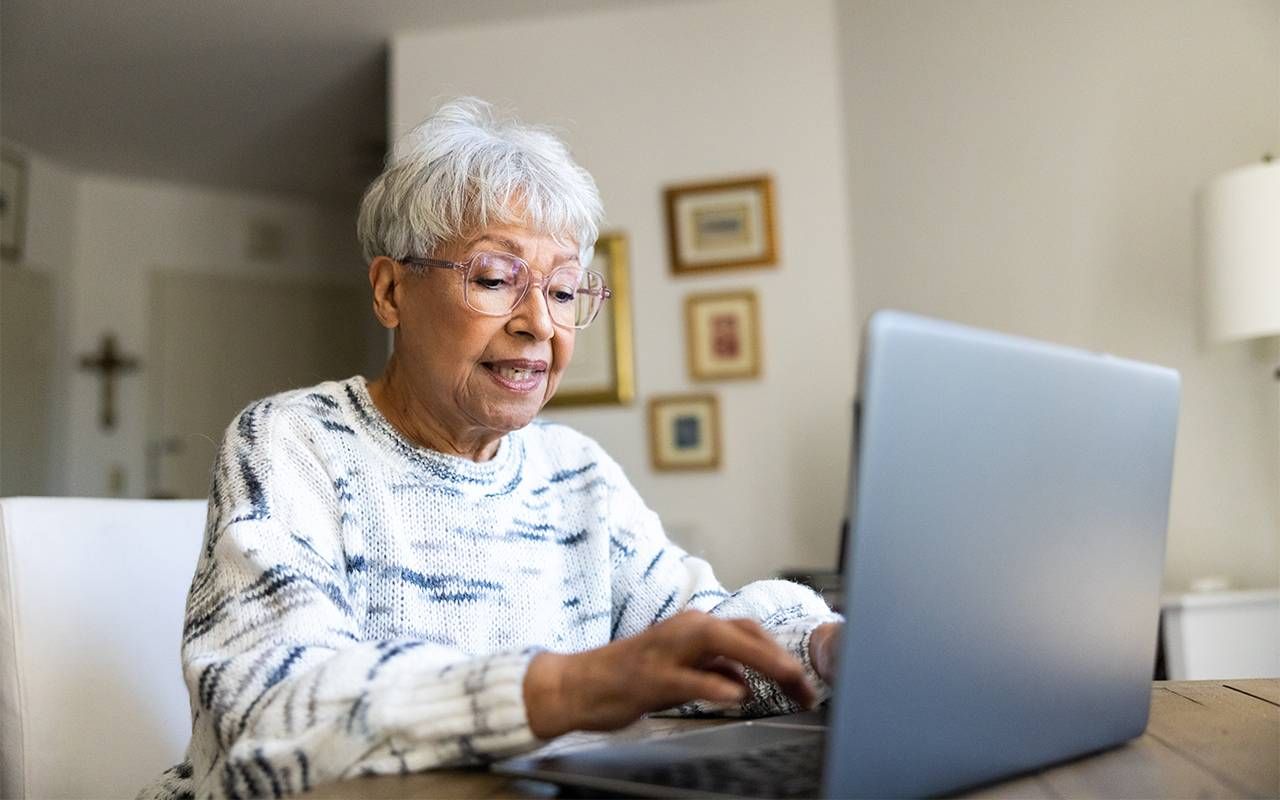Bridging the Digital Divide Through Education and Empowerment
As society increasingly relies on digital platforms, addressing the digital divide remains a crucial concern for older adults and their families to prioritize
As the COVID-19 pandemic swept across the United States in early 2020, lockdown measures prompted a rapid migration of various activities from in-person to online platforms. From business meetings to health care appointments, family gatherings, concerts and even real estate viewings, virtually everything transitioned to the digital realm.

While this transition brought forth exciting possibilities for remote connectivity and access to vital services and information from the safety of one's home, it also exposed how certain demographics remained at risk of being left behind in an increasingly digital landscape.
Those lacking reliable broadband internet access or the necessary technological proficiency found themselves unable to adapt to this shift, with limited alternative solutions available. Among the groups most profoundly impacted by this digital divide were older adults, particularly those from low-income backgrounds.
Among the groups most profoundly impacted by this digital divide were older adults, particularly those from low-income backgrounds.
"The pandemic took the most isolated segment of our population and made them further isolated," says Mike Billnitzer, Vice President of Financial Wellness and Housing & Homeownership at Cleveland-based nonprofit Benjamin Rose. "Not only were older adults the most susceptible to the virus, but many were low-to-moderate income, not tech savvy, and had mobility or transportation issues. Putting that all together, they became challenging for service providers to reach, and it became difficult for them to seek assistance for their health, finances or housing concerns."
As the pandemic's impact lingers and society increasingly relies on digital platforms, addressing the digital divide remains a crucial concern for older adults and their families to prioritize.
Navigating a Digital Landscape: Challenges Faced by Older Adults
Statistics show that the internet is most commonly used for communication, general web browsing and social media, but that most also use it for navigation, streaming, online shopping, productivity, health, banking and accessing social services on a regular basis.
"The older adult generation didn't grow up with that kind of technology," Billnitzer says. "When the advent of major innovations like the Internet and digital banking happened, they were used to a world where they didn't require those tools to get by. We've seen things like telehealth, buying food and other necessities, digital payments and so on become the norm for everyone else, but all of that isn't as available to older adults, which puts them at a real disadvantage when managing their basic needs in the modern landscape."
Billnitzer argues that there can be real consequences to being unable to connect to health, finances, transportation and social services digitally.
While streaming and social media might not be as important to older adults, Billnitzer argues that there can be real consequences to being unable to connect to health, finances, transportation and social services digitally.
"Older adults are already more likely than anyone else to be hindered by lack of transportation," says Billnitzer. "When they're unable to seek out assistance directly, there needs to be an easy way for them to connect to it remotely. But more and more, we're seeing places not even listing their phone numbers prominently, but saying 'visit our website,' 'download our app' or 'schedule online.' We take for granted things like scheduling a physician appointment online and receiving text message appointment reminders, but many older adults don't know how to do that."
Billnitzer also points out that during the pandemic, younger generations could order groceries and other necessities at home to avoid going out and risking exposure. "That wasn't an option for most older adults, so they were going out into the community to get what they needed, even when they were at risk," Billnitzer explains. "With COVID resurging, they're going to be at risk again."
The COST Program: Bridging the Gap with Education and Resources
Working for Benjamin Rose, an organization which provides many of its services for older adults in-home and out in the community, Billnitzer immediately encountered challenges providing financial and housing help to older adults when the pandemic hit in 2020.
Financial counseling has always been the backbone of Benjamin Rose's financial assistance services, so Billnitzer and his team began looking for ways to help older adults engage in this vital education remotely while not ignoring the reality of the digital divide.
"We realized that we needed to teach older adults how connect digitally to fight back against the effects of their isolation."
"We realized that we needed to teach older adults how connect digitally to fight back against the effects of their isolation," Billnitzer says. "And not just teach them, but give them the knowledge, skills, and access to resources to be able to navigate the digital world. A lot of organizations were handing older adults laptops at that time, but not giving them the rest of the equation. We wanted to give them everything."
To do this, Benjamin Rose partnered with the Ashbury Senior Community Computer Center and DigitalC, a Cleveland-based nonprofit which connects underserved communities to reliable broadband. With the support of an investment from Huntington Bank and refurbished laptops provided by RET3, the eight-week Connecting Our Seniors to Technology program (COST) was developed.
Transforming Lives: COST Success Stories
From its beginning, COST has served as a model to prove that an engaged and motivated audience can both learn and retain new skills, disproving the old adage "You can't teach an old dog new tricks."
"The feedback of most of the clients who participate in COST is that their technology knowledge has increased, and that they feel more comfortable operating a computer and navigating the internet," Taylor says.
Taylor's favorite COST success story is 'Mr. M,' a homeless client working to turn his life around after surviving a serious health scare. "He has expressed to us how much he learned in the program, and how much he enjoyed the opportunity to meet new people throughout the process," says Taylor. According to Taylor, having a laptop and internet access has made an enormous difference in Mr. M's ability to access services, especially medical and housing support, and he no longer has the same fears of ending up in a dire situation without help.
"Don't underestimate the power of older adults and their desire to continue to learn and grow."
As for Billnitzer, his proudest moment was when client 'Mr. H' participated in the 2023 Age-Friendly Banking Convening to share the importance of programs like COST for older adults like him, and was able to join the meeting on Zoom entirely on his own.
"He came to us without a computer, without broadband access, without really any prior knowledge," says Billnitzer. "But after the program, he was able to independently use a digital platform like Zoom to share his story about how he can now stay connected to his family thanks to technology."
Billnitzer adds, "A lot of our participants stay in touch with each other via email. At the beginning of the class, most of them didn't know how to use email. But after going through the program and getting their laptop, they're staying in touch using the technology we taught them. To me, that's an amazing measure of success."
Empowering Older Adults Digitally: Tips for Families and Caregivers
So what can families, caregivers and service providers for older adults adapt from a program like COST?
The COST team recommends the following tips to get started:
· Seek out group classes like COST at senior centers, libraries or nonprofit organizations. Learning alongside peers at a similar skill level can boost comfort and confidence.
· Tailor the instruction to what directly matters to the individual. If they aren't interested in social media or word processing, focus on their specific goals, such as video calling with family or scheduling online appointments.
· Use demonstration to teach and ensure they can replicate the actions multiple times before moving on to the next topic.
· Always maintain a patient and respectful approach, understanding that they may not have had prior exposure to these technologies. Never make them feel ignorant for not knowing something that wasn't a part of their earlier life experiences.
The most important thing, according to Billnitzer, is to not write older adults off. "Don't underestimate the power of older adults and their desire to continue to learn and grow," he says. "You just have to meet them where they are."


